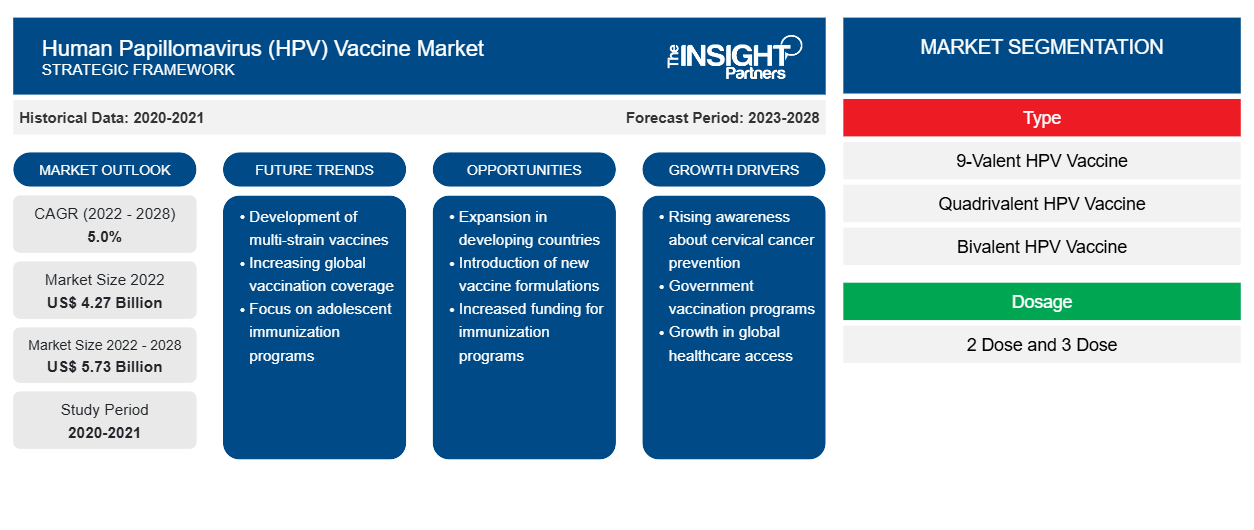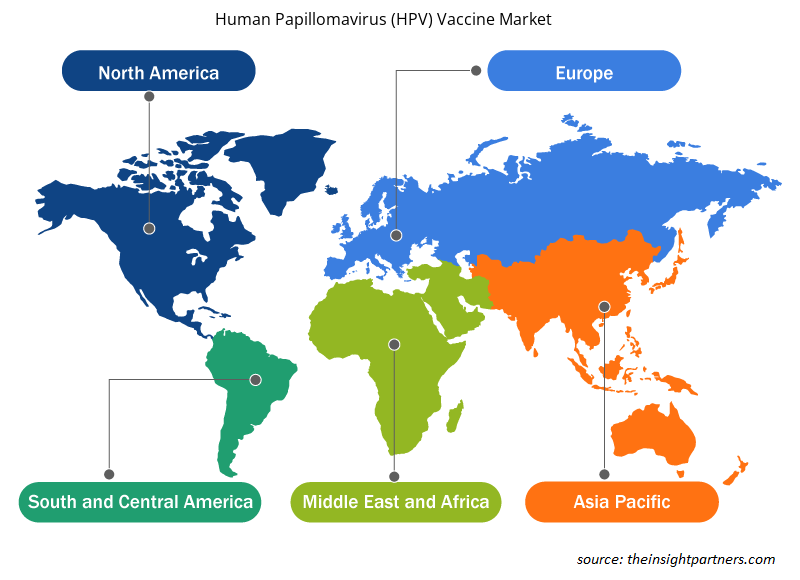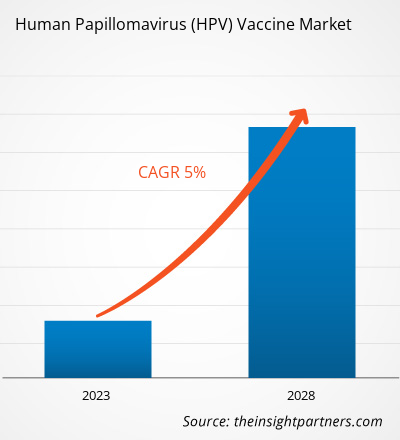The human papillomavirus (HPV) vaccine market was valued at US$ 4,273.84 million in 2022 and is projected to reach US$ 5,730.50 million by 2028; it is expected to grow at a CAGR of 5.0% from 2022 to 2028.
Human papillomaviruses (HPV) is a diverse group of DNA-based viruses that infect the mucous and skin membranes of humans and various animals. More than 100 different types of HPV have been characterized. The increasing prevalence of various cancers caused by HPV is expected to drive the human papillomavirus (HPV) vaccine market during the forecast period. According to the Centers for Disease Control and Prevention (CDC), HPV is the most common sexually transmitted infection in the US. Over 60% of penile cancers, 70% of vulvar and vaginal cancers, and 90% of anal and cervical cancers are caused due to HPV infection. CDC also states that about 14 million people are newly infected by the virus every year in the US.
Customize This Report To Suit Your Requirement
You will get customization on any report - free of charge - including parts of this report, or country-level analysis, Excel Data pack, as well as avail great offers and discounts for start-ups & universities
Human Papillomavirus (HPV) Vaccine Market: Strategic Insights

- Get Top Key Market Trends of this report.This FREE sample will include data analysis, ranging from market trends to estimates and forecasts.
You will get customization on any report - free of charge - including parts of this report, or country-level analysis, Excel Data pack, as well as avail great offers and discounts for start-ups & universities
Human Papillomavirus (HPV) Vaccine Market: Strategic Insights

- Get Top Key Market Trends of this report.This FREE sample will include data analysis, ranging from market trends to estimates and forecasts.
The global human papillomavirus (HPV) vaccine market is segmented on the basis of type, dosage, age, distribution channel, and geography. The market, by region, is segmented into North America, Europe, Asia Pacific, the Middle East & Africa, and South & Central America. The report offers insights and in-depth analysis of the human papillomavirus (HPV) vaccine market, emphasizing on various parameters such as market trends, technological advancements, and market dynamics. It also includes the competitive landscape analysis of leading market players across the globe.
Market Insight
Increase in Prevalence of HPV Associated Diseases
Increase in Prevalence of HPV Associated Diseases
Human papillomavirus (HPV) is a common sexually transmitted infection and can cause cervical, oropharyngeal cancer, and cancer of the vagina, vulva, penis, or anus. It also causes various diseases, such as anogenital warts and recurrent respiratory papillomatosis. HPVs have also been detected in lichen sclerosus, skin tags, seborrheic keratoses, epidermal cysts, actinic keratoses, and psoriatic plaques. A significant burden of HPV-associated diseases is likely to drive the market's growth.
In women, cervical cancer is the fourth most common cancer. As per the World Health Organization (WHO) report estimation, in 2018, an estimated 570,000 women worldwide had cervical cancer, and about 311,000 female deaths were due to cervical cancer. Additionally, the American Society of Clinical Oncology (ASCO) estimated that around 14,100 cases of invasive cervical cancer would be registered in the US alone. Further, as per the report, 'Cervical cancer burden in EU-27,' in 2020, there were 30,447 new cases and 13,437 deaths due to cervical cancer in women.
Further, as per the Centers for Disease Control and Prevention (CDC), in 2018, there were around 43 million HPV infections in the US. The CDC also estimated that about 19,400 women and 12,100 men annually suffer from cancers caused by HPV. Further, as per the National Foundation for Infectious Diseases (NFID), there are around 14 million new HPV infection cases in the US every year. In addition, as per the report, titled 'Human Papillomavirus and Related Diseases Report-Europe,' in 2020, 8,449 women and 4,327 men had anal cancer in Europe.
Such a high incidence of HPV associated infections across the world is likely to favor the overall market growth in the coming years.
Type-Based Insights
Based on type, the human papillomavirus (HPV) vaccine market is segmented into 9-valent HPV vaccine, quadrivalent HPV vaccine, and bivalent HPV vaccine. In 2022, the quadrivalent HPV vaccine segment holds the largest market share. However, the market for the 9-valent HPV vaccine segment is expected to witness the rapid growth from 2022 to 2028. The quadrivalent human papillomavirus (HPV) vaccine protects against infection with HPV types 6, 11, 16, and 18, which are responsible for 70% to 80% of cervical cancers and at least 90% of genital warts cases. The vaccine reduces the risk of genital warts and the precursor lesions of cervical, vaginal, and vulvar cancers caused by the virus.
Dosage-Based Insights
Based on dosage, the human papillomavirus (HPV) vaccine market is segmented into 2 dose and 3 dose. In 2022, the 2 dose segment accounts for a larger market share.
Age-Based Insights
The global human papillomavirus (HPV) vaccine market, based on age, is segmented into 9 to 14 years and 15 to 45 years. The 9 to 14 years segment held a larger market share in 2022, and the same segment is anticipated to register a higher CAGR during the forecast period.
Application–Based Insights
In terms of application, the global human papillomavirus (HPV) vaccine market is segmented into HPV-attributable cancers and genital warts. The HPV-attributable cancers segment holds a larger market share in 2022, and the same segment is anticipated to register a higher CAGR during the forecast period.
Distribution Channel–Based Insights
On the basis of distribution channel, the global human papillomavirus (HPV) vaccine market is segmented into doctors office, community health clinics, school-based health centers, health departments, hospitals, and others. The hospitals segment holds the largest share of the market in 2022, and the school-based health centers segment is anticipated to register the highest CAGR in the market during the forecast period.
The COVID-19 pandemic is likely to have longer-term consequences on the HPV vaccine business. Many primary care clinics in the US have continued to operate at a reduced capacity to abide by social distancing measures and adopt stringent cleaning protocols. A reduction in in-person office visits limits opportunities for vaccine providers to discuss and deliver vaccines. Barriers in transportation are likely to harm HPV vaccination; pharma and biotech companies traditionally find it difficult to market vaccines among the masses because of resistance received from parents and the absence of widespread awareness about school entry requirements that support other adolescent vaccines. The available evidence indicates that the COVID-19 pandemic has dramatically disrupted the delivery of HPV vaccines in 2020 and 2021. Early reports by CDC, suggest that ordering and billing dropped by >70% in March 2020. Furthermore, a 25–50% decrease in HPV vaccine orders continued in June 2020, in contrast to other early childhood-vaccine orders that resurged to near pre-pandemic levels. Although the revival of the HPV vaccine market is in progress, available data suggest that a short-term decline in HPV vaccination coverage will be substantial, and the demand for HPV vaccine will grow across North America in long term.
Human Papillomavirus (HPV) Vaccine Market Regional Insights
The regional trends and factors influencing the Human Papillomavirus (HPV) Vaccine Market throughout the forecast period have been thoroughly explained by the analysts at The Insight Partners. This section also discusses Human Papillomavirus (HPV) Vaccine Market segments and geography across North America, Europe, Asia Pacific, Middle East and Africa, and South and Central America.

- Get the Regional Specific Data for Human Papillomavirus (HPV) Vaccine Market
Human Papillomavirus (HPV) Vaccine Market Report Scope
| Report Attribute | Details |
|---|---|
| Market size in 2022 | US$ 4.27 Billion |
| Market Size by 2028 | US$ 5.73 Billion |
| Global CAGR (2022 - 2028) | 5.0% |
| Historical Data | 2020-2021 |
| Forecast period | 2023-2028 |
| Segments Covered |
By Type
|
| Regions and Countries Covered | North America
|
| Market leaders and key company profiles |
Human Papillomavirus (HPV) Vaccine Market Players Density: Understanding Its Impact on Business Dynamics
The Human Papillomavirus (HPV) Vaccine Market is growing rapidly, driven by increasing end-user demand due to factors such as evolving consumer preferences, technological advancements, and greater awareness of the product's benefits. As demand rises, businesses are expanding their offerings, innovating to meet consumer needs, and capitalizing on emerging trends, which further fuels market growth.
Market players density refers to the distribution of firms or companies operating within a particular market or industry. It indicates how many competitors (market players) are present in a given market space relative to its size or total market value.
Major Companies operating in the Human Papillomavirus (HPV) Vaccine Market are:
- Merck & Co. In.
- GSK
- Serum Institute of India
- Walvax Biotechnologies
- Innova
Disclaimer: The companies listed above are not ranked in any particular order.

- Get the Human Papillomavirus (HPV) Vaccine Market top key players overview
Companies commonly adopt product launches and expansion strategies to expand their footprint worldwide, meet the growing demand, and expand their product portfolio. The players operating in the global human papillomavirus (HPV) vaccine market implement the strategy of product innovation for changing customer demand worldwide, which also permits them to maintain their brand name globally.
- In May 2022, China’s National Medical Products Administration (NMPA) approved GlaxoSmithKline’s (GSK) two-dose vaccine schedule, Cervarix, in girls from 9 to 14 years to prevent cervical cancer. Cervarix is a recombinant, noninfectious, AS04-adjuvanted HPV bivalent (types 16, 18) vaccine.
- n May 2022, Serum Institute of India announced the development of a tetravalent HPV vaccine including L1 VLPs of serotypes 6,11,16,18, which is expected to give a coverage of ~90% against papillomavirus. The vaccine is currently under development.
- In May 2020, Shanghai Bovax Biotechnology collaborated with Chongoing Bovax Biopharmaceutical to evaluate the immunogenicity and safety of 4-valent and 9-valent HPV recombinant vaccines.
By geography, the human papillomavirus (HPV) vaccine market is segmented into North America (the US, Canada, and Mexico), Europe (the UK, Germany, France, Italy, Spain, Russia, Belarus, and the Rest of Europe), Asia Pacific (China, Japan, India, Australia, Southeast Asia, New Zealand, South Korea, and the Rest of Asia Pacific), the Middle East & Africa (the UAE, Saudi Arabia, South Africa, Iran, Turkey, Kuwait, Bahrain, Egypt, and the Rest of Middle East & Africa), and South & Central America (Brazil, Argentina, Chile, Guatemala, Peru, Colombia, and the Rest of South & Central America). GSK; Innovax; Walvax; Serum Institute of India Pvt., Ltd.; Vaccitech; Innovio Pharmaceuticals; Merck & Co., Inc.; 2A Pharm; ChengDu Institute of Biological Products Co., Ltd.; Sanofi; R-Pharm; Shanghai Bowei; and BioLeaders are among the leading companies operating in the market.
Frequently Asked Questions
Who are the major players in market the human papillomavirus vaccine market?
The human papillomavirus vaccine market majorly consists of the players such Merck & Co. In., GSK, Serum Institute of India, Walvax Biotechnologies, Innovax, Vaccitech, Innovio Pharmaceuticals, Chengdu Institute of Biological Products Co., Ltd., Sanofi, R-Pharm, Shanghai Bowei, and Bioleaders amongst others.
Which segment is dominating the human papillomavirus vaccine market?
The human papillomavirus vaccine market, by type, is bifurcated 9-valent HPV vaccine, quadrivalent HPV vaccine, and bivalent HPV vaccine. In 2022, the quadrivalent HPV vaccine segment held the largest share of the market, by type. However, the 9-valent HPV vaccine segment is expected to witness the fastest growth during 2022 to 2028.
What are the driving factors for the human papillomavirus vaccine market across the country?
Driving factor such as increase in prevalence of HPV associated diseases and initiatives taken by global health organizations are likely to have a positive impact on the growth of the global human papillomavirus (HPV) vaccines market. Whereas factors, such as growing number of HPV awareness programs, are likely to create a growth opportunity on the HPV vaccines market in the near future.
What is the human papillomavirus vaccine market?
Human papillomaviruses is a diverse group of DNA-based viruses that infect the mucous and skin membranes of humans and various animals. More than 100 different types of human papillomavirus have been characterized. Increasing prevalence of various cancers caused by human papillomavirus is expected to drive the market during the forecast period. According to the Centers for Disease Control and Prevention (CDC), human papillomavirus is the most common sexually transmitted infection in the U.S. Over 60% of penile cancers, 70% of vulvar and vaginal cancers, and 90% of anal and cervical cancers are caused due to human papillomavirus infection. CDC also states that about 14 million people are newly infected by human papillomavirus every year in the U.S.
- Historical Analysis (2 Years), Base Year, Forecast (7 Years) with CAGR
- PEST and SWOT Analysis
- Market Size Value / Volume - Global, Regional, Country
- Industry and Competitive Landscape
- Excel Dataset
Testimonials
Reason to Buy
- Informed Decision-Making
- Understanding Market Dynamics
- Competitive Analysis
- Identifying Emerging Markets
- Customer Insights
- Market Forecasts
- Risk Mitigation
- Boosting Operational Efficiency
- Strategic Planning
- Investment Justification
- Tracking Industry Innovations
- Aligning with Regulatory Trends
Yes! We provide a free sample of the report, which includes Report Scope (Table of Contents), report structure, and selected insights to help you assess the value of the full report. Please click on the "Download Sample" button or contact us to receive your copy.
Absolutely — analyst assistance is part of the package. You can connect with our analyst post-purchase to clarify report insights, methodology or discuss how the findings apply to your business needs.
Once your order is successfully placed, you will receive a confirmation email along with your invoice.
• For published reports: You’ll receive access to the report within 4–6 working hours via a secured email sent to your email.
• For upcoming reports: Your order will be recorded as a pre-booking. Our team will share the estimated release date and keep you informed of any updates. As soon as the report is published, it will be delivered to your registered email.
We offer customization options to align the report with your specific objectives. Whether you need deeper insights into a particular region, industry segment, competitor analysis, or data cut, our research team can tailor the report accordingly. Please share your requirements with us, and we’ll be happy to provide a customized proposal or scope.
The report is available in either PDF format or as an Excel dataset, depending on the license you choose.
The PDF version provides the full analysis and visuals in a ready-to-read format. The Excel dataset includes all underlying data tables for easy manipulation and further analysis.
Please review the license options at checkout or contact us to confirm which formats are included with your purchase.
Our payment process is fully secure and PCI-DSS compliant.
We use trusted and encrypted payment gateways to ensure that all transactions are protected with industry-standard SSL encryption. Your payment details are never stored on our servers and are handled securely by certified third-party processors.
You can make your purchase with confidence, knowing your personal and financial information is safe with us.
Yes, we do offer special pricing for bulk purchases.
If you're interested in purchasing multiple reports, we’re happy to provide a customized bundle offer or volume-based discount tailored to your needs. Please contact our sales team with the list of reports you’re considering, and we’ll share a personalized quote.
Yes, absolutely.
Our team is available to help you make an informed decision. Whether you have questions about the report’s scope, methodology, customization options, or which license suits you best, we’re here to assist. Please reach out to us at sales@theinsightpartners.com, and one of our representatives will get in touch promptly.
Yes, a billing invoice will be automatically generated and sent to your registered email upon successful completion of your purchase.
If you need the invoice in a specific format or require additional details (such as company name, GST, or VAT information), feel free to contact us, and we’ll be happy to assist.
Yes, certainly.
If you encounter any difficulties accessing or receiving your report, our support team is ready to assist you. Simply reach out to us via email or live chat with your order information, and we’ll ensure the issue is resolved quickly so you can access your report without interruption.















The List Of Companies - HPV Vaccines Market
- Merck & Co. In.
- GSK
- Serum Institute of India
- Walvax Biotechnologies
- Innova
- Vaccitech
- Innovio Pharmaceuticals
- Chengdu Institute of Biological Products Co., Ltd.
- Sanofi
- R-Pharm
- Shanghai Bowei
- Bioleaders






 Get Free Sample For
Get Free Sample For